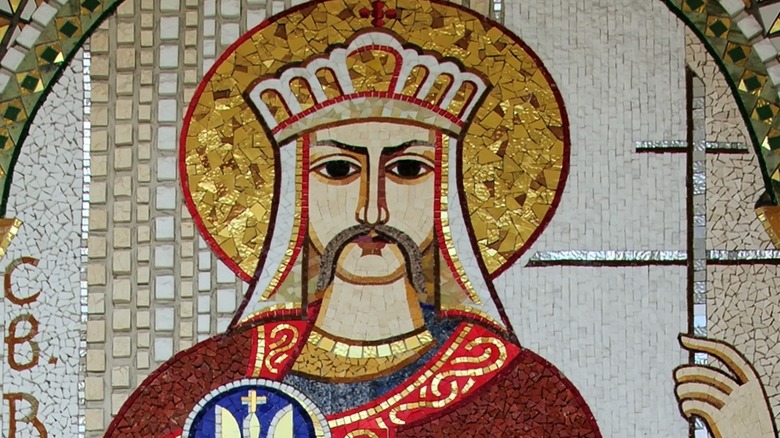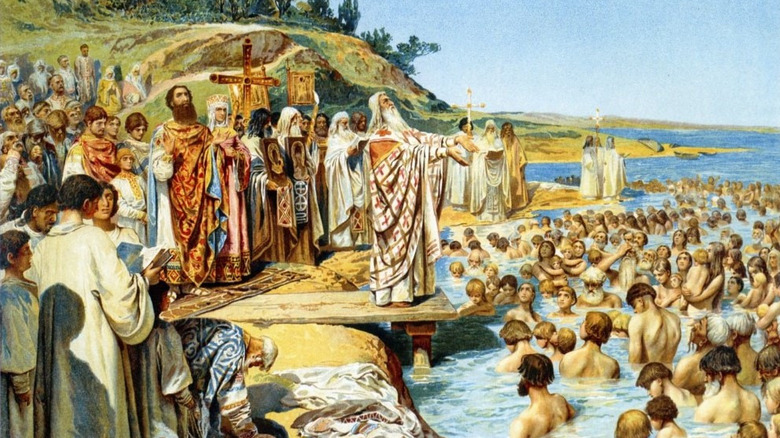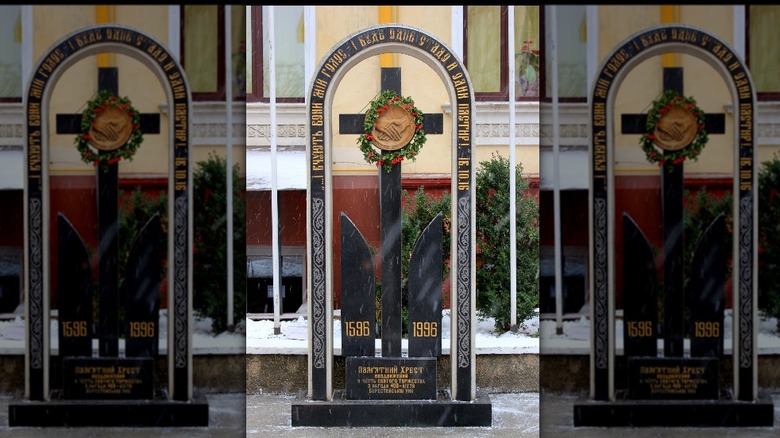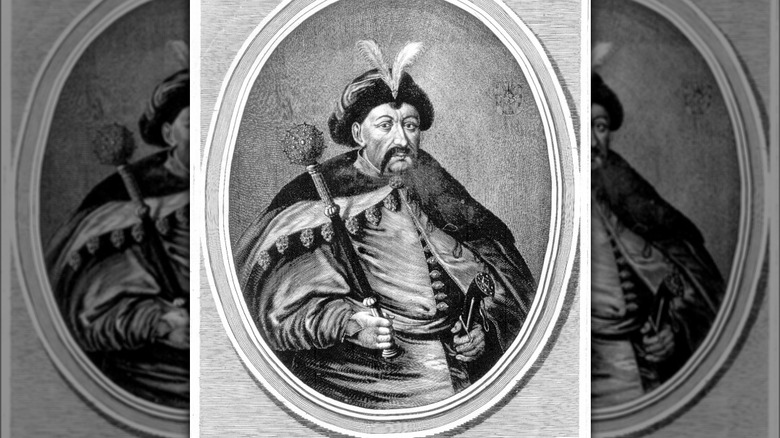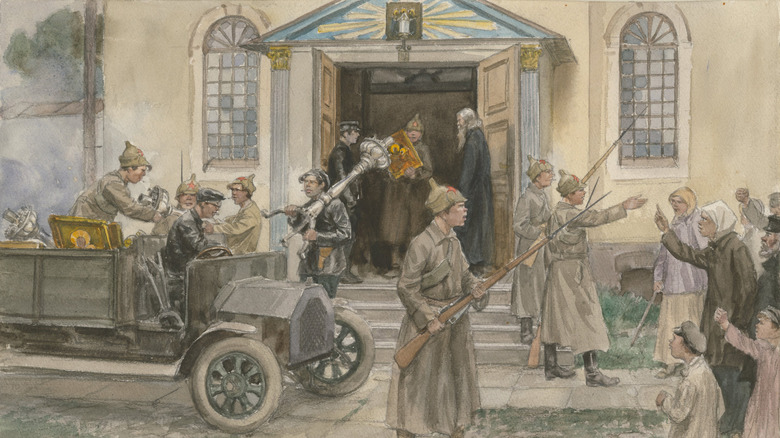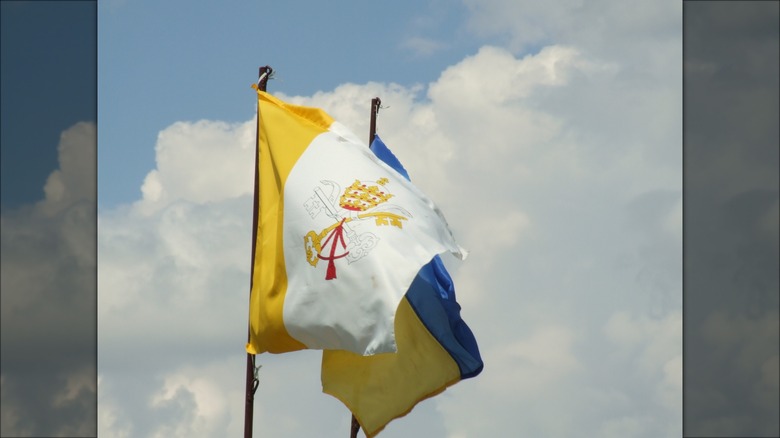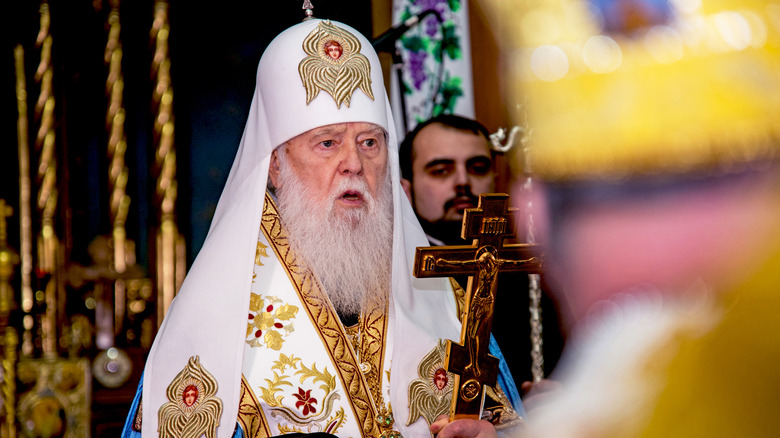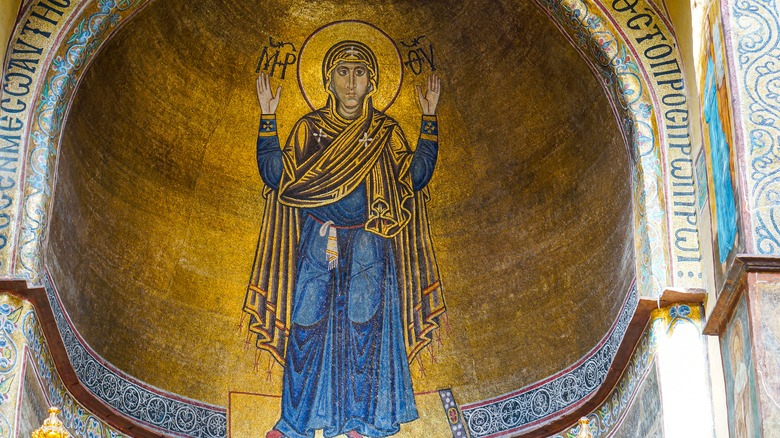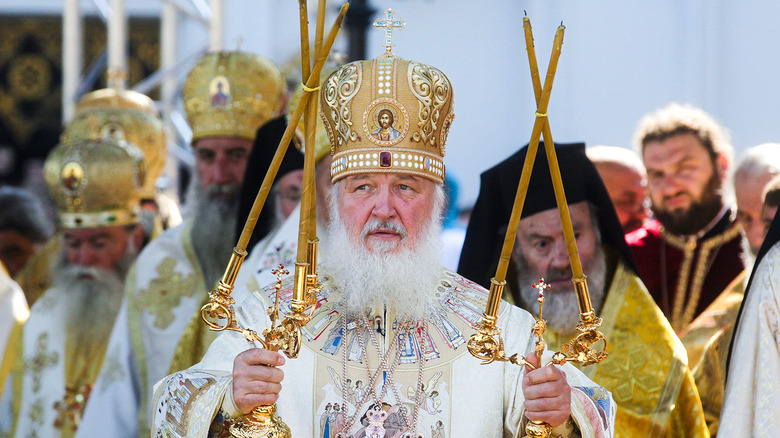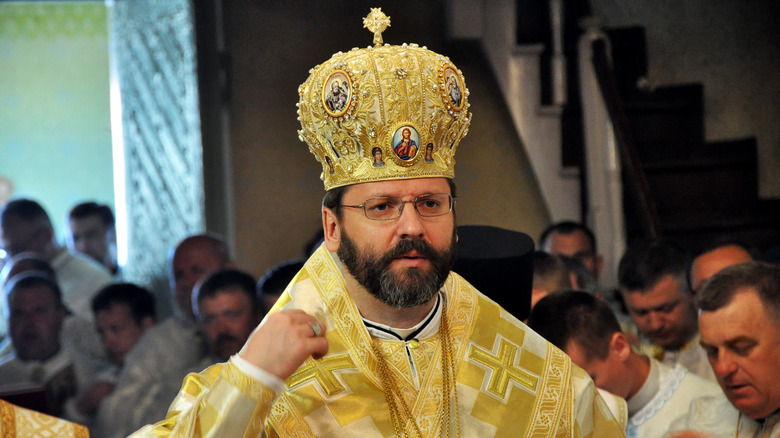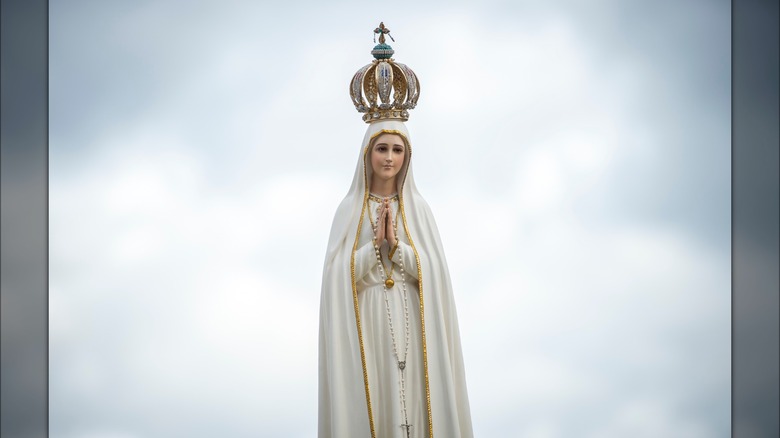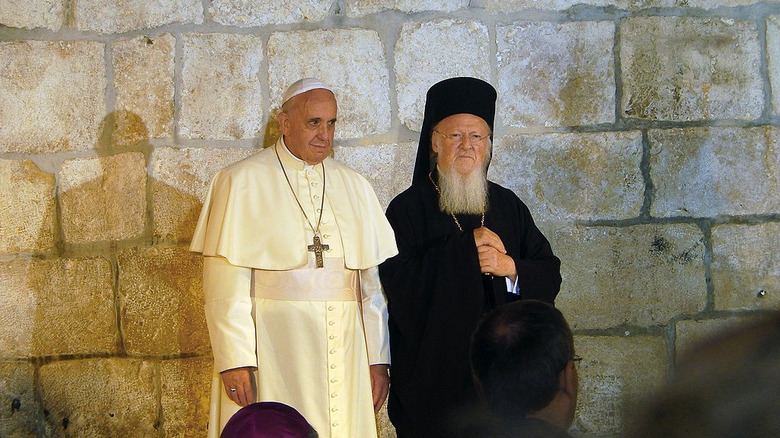The Long History Of Russo-Ukrainian Religious Conflict
The conflict in Ukraine in 2022 is widely seen through the lens of a Russian-American conflict over Ukrainian membership in NATO. Politically speaking, this is certainly true. But Americans are unaware that the politics mask another conflict that has racked Ukraine for centuries. This one is a religious conflict between Ukraine's Orthodox and Catholic Churches and the Russian Orthodox Church. As First Things notes, at stake in this particular conflict are two competing visions of Ukrainian religion. On one hand is the view that Ukraine is part of Russia, and therefore, so are its Christians. On the other side is the view that Ukrainians are the true heirs of the church that St. Volodymyr established in Kyiv in 988.
The religious aspects of the conflict have not frequently appeared in American media, but have been all over Catholic and Orthodox media as tensions risk splitting the Orthodox Church and alienating Russia from the Catholic world. But some believe the Ukraine conflict goes beyond this world. Devout Catholics and Orthodox Christians have argued that the divine has taken a direct interest in this conflict, suggesting that solving the Russia-Ukraine crisis may be the key to peace in the world. Here is the history of the Russo-Ukrainian conflict's religious dimension.
The roots of East Slavic Christianity
The East Slavic tribes of the early Middle Ages, per the Polish Review, were originally pagans, worshiping a handful of deities associated with nature. But Christianity began to spread in these lands as missionaries from Western Europe and the Byzantine Empire worked their way through Central Europe and the Balkans. The new faith soon began to acquire converts in the Kievan Rus' state, the forerunner to Russia, Ukraine, and Belarus.
An account recorded in the Russian Primary Chronicle tells that Grand Prince Volodymyr of Kyiv offered Greek and German Christians, Muslims, and Jews the chance to convince him of their faiths. Volodymyr rejected Judaism, taking the Jewish people's exile from the Promised Land as a sign of God's disfavor. Although Islam allowed polygamy and guaranteed the devout an afterlife full of sexual pleasure, Volodymyr had no interest in circumcision or giving up alcohol and pork. The German missionaries threw the prince off with their sermons on fasting and moderation.
Volodymyr was drawn to Greek Christianity, but, wanting to be sure, he sent delegations to observe the religions in practice. They found Constantinopolitan Greek Christianity was heavenly and visually beautiful. Volodymyr accepted baptism and married the Byzantine emperor's sister Anna Makedonska. With him came the definitive Christianization of Rus' that gradually replaced paganism. For his proselytism, Volodymyr is regarded as a saint in the Catholic and Orthodox Churches.
The Great Schism
When St. Volodymyr Christianized the Rus' people, there was still one united Christian church (at least on paper). But beginning in 1054, the Eastern and Western halves of the Catholic (a.k.a. universal) Church began to drift apart, as both halves laid claim to being the One True Catholic Church (per OCA, the Orthodox Church is properly called "the Orthodox Catholic Church").
The reasons for the split are complicated, but according to the OCA, it revolved around papal intervention in Byzantine Christian affairs. In 1054, according to the Catholic Encyclopedia, a papal legate and the Patriarch of Constantinople excommunicated each other. The two churches drifted in and out of schism, until 1453, when, according to historian Philip Mansel, the Ottoman conquest of Constantinople allowed Sultan Mehmet II to appoint the patriarchs of the Orthodox Church. Mehmet inserted an anti-Roman bishop named Gennadios Scholarios, who ended any attempts to reunite with Rome and crystallized the split.
With the Great Schism, the lands of old Rus' became part of the Orthodox world thanks to their close ties with Byzantium. But they soon came under the pagan Grand Duchy of Lithuania. According to Russia Beyond, there was a chance that Lithuania might embrace Orthodoxy, but political convenience brought it to Catholicism instead. The Lithuanian conquest of Kyiv and conversion to Christianity set the scene for Catholicism to make a triumphant return to the Rus' lands in the 16th century and plant the seeds of a modern conflict that has been on the minds of many a Ukrainian Catholic clergyman.
Catholicism returns to Ukraine: The Union of Brest
As Russia Beyond notes, Lithuania's conversion to Catholicism brought its Orthodox Rus' territories into Polish Catholic hands. According to New Advent, the Ruthenian Orthodox Church was in shambles at the time, giving Jesuit missionaries a chance to reel in dissatisfied clergymen who thought that union with Rome might provide a solution to some of their problems. According to St. Josephat's UGCC, there was another reason. The Orthodox lands of Ruthenia were coming under the auspices of the Patriarchate of Moscow, located within the Tsardom of Russia and a competitor of Poland.
Regardless of the motivation, Ruthenia's leading clergymen threw their lot in with Rome, Poland, and the pope with the 1596 Union of Brest. In effect, the document was a compromise. The former Orthodox, who would be known as Greek Catholics, were allowed to maintain their traditions, such as married clergy, the eastern Divine Liturgy, icons, and their particular versions of Christian prayers such as the Nicene Creed. But not everyone in Ukraine was for it, setting the stage for a clash with the Orthodox Tsardom of Russia, which was determined to enforce the authority of the Moscow Patriarchate upon the whole of old Rus'.
Russia enters the scene
The Orthodox Cossack Hetmanates of Central and Eastern Ukraine were among Poland's most implacable foes, and their hostility extended to their enemies' Catholic faith. According to Emerging Europe, Cossack hetman Bohdan Khmeltnytsky (above), waged a bloody war against Poland and the Catholic Church, which he viewed as intruders on Orthodox Cossack land. In 1648, he fatefully enlisted the support of his co-religionists in Russia ... and accidentally surrendered his independence and that of the Ruthenian Orthodox Church.
In 1654, Russians and Cossacks signed the Treaty of Pereyaslav. For the Cossacks, this document was supposed to be a temporary alliance. But as the book "Russian Nationalism and the Russia-Ukraine Conflict" explains, Moscow saw the treaty as a reunification of Russia with the Ukrainians, whom they called "Little Russians." Ukrainian historians generally view the treaty as a betrayal, but with the 1686 Eternal Treaty (via EoU), it became reality. Poland ceded Kyiv and everything east of it to Russia, who would eventually annex the rest of Ukraine except for the far western part of the country.
The Russian annexation put the majority of old Kievan Rus' firmly Orthodox hands. Only the westernmost part of the country escaped Russian rule, falling instead under Catholic Austria. The Ukrainian-speaking lands were now religiously split, setting the seeds for a series of 20th-century religious conflicts with Russia that resonate to this day.
Confronting Soviet Russia
The Russian annexation of large parts of Ukraine brought it into direct conflict with the (Ukrainian) Greek Catholic Church, which became a target of tsarist and later Soviet liquidation. According to Prof. Joseph Loya of Villanova, Imperial Russia liquidated Greek Catholicism in its Ukrainian and Belarussian territories during the 18th and 19th centuries and returned these regions to Orthodoxy. But worst persecution came in the 20th century following the Soviet annexation of Western Ukraine.
According to Dr. Roman Kordonski of the University of Olsztyn, the Soviet Union attempted to subjugate the Ukrainian Greek Catholic Church, which was closely identified with Ukrainian nationalism, under the Russian Orthodox Patriarchate of Moscow. But as the Encyclopedia of Ukraine notes, the UGCC was too strong and too loyal to Rome. So Joseph Stalin liquidated it. The church's bishops were arrested and deported to labor camps in Siberia while a state-controlled committee set about "reuniting" the UGCC with the Russian Orthodox Church in Moscow.
The 1946 Synod of Lviv was a complete sham. The Soviet authorities had written up the documents of reunification, which were widely condemned in the Catholic world. The remaining UGCC clergy loyal to Rome went into hiding or exile, while the ROC took their properties. Ukraine was now completely Orthodox in name but under the Soviet-controlled ROC. Ukraine's Catholics have not forgotten the role the ROC played in the persecutions of the 1940s, a period that has stoked tensions and Ukrainian nationalism in the 2022 conflict.
Relevance to today's conflict
Because of the close ties between Ukrainian and Russian nationalism and their respective churches, the current conflict has an important religious dimension that few Americans are aware of. The National Catholic Reporter reported that Moscow Patriarch Kirill has given his blessing to the Russian war in Ukraine. Given the Russian Orthodox Church's past in its country, the Ukrainian Greek Catholic Church unsurprisingly views the Russian invasion as a direct attack on its existence to forcibly integrate it into the ROC.
Today, the UGCC dominates Western Ukraine with ~5 million adherents. But despite only making up ~10% of the population, as Biblical Studies notes, the UGCC has often been positioned as Ukraine's de facto national church. This position is easy to understand. The UGCC is a thoroughly Ukrainian institution with complete religious, linguistic, and political independence from Russia, as opposed to Ukraine's Orthodox churches where the situation is more complicated.
But this complete independence, per the Church in Need, makes the UGCC a target. Archbishop of Philadelphia Boris Gudziak has argued that wherever Russia goes, the UGCC dies. Patriarch Kirill of Moscow and Russian President Vladimir Putin, he argues, have weaponized the ROC against the UGCC and even tried to kill UGCC Patriarch Sviatoslav Shevchuk. As a result, as Vatican News notes, the UGCC is among the biggest defenders of Ukraine's independence. Patriarch Shevchuk has regularly appealed to Catholics for support for Ukrainian sovereignty because history suggests that in a Russian Orthodox-dominated Ukraine, there is no space for a Ukrainian national institution such as the UGCC loyal to an outsider such as the pontiff.
Ukraine's two Orthodox churches
While Ukraine's Catholics are independent of Moscow, the situation of Ukrainian Orthodoxy is a bit more complicated and presents another facet of the Russo-Ukrainian conflict. According to Radio Free Europe, there are two Ukrainian Orthodox Churches. One is under Patriarch Kirill of Moscow, while the other one is not. Many of the problems stem from the unification of the two churches and the assumptions that underlie its basis.
Ukrainians widely consider the arrangement illegitimate. According to the Ukrainian outlet GaliNews, the Orthodox Church in Ukraine was separate from Moscow under Constantinople. Then Russia incorporated Ukrainian Orthodoxy into the Moscow Patriarchate unilaterally in 1686. By the book, all Orthodox patriarchs, especially Constantinople, should have had a say in the transfer, but such a synod never occurred. But according to "Russian Nationalism and the Russian-Ukrainian Conflict," Russia viewed its annexation of Ukraine as reunification with its Rus' brothers. Logically, if Russia was the heir of old Rus', then the Kievan church should rightfully be subject to Moscow. Today, this church is called the Ukrainian Orthodox Church of the Moscow Patriarchate.
According to the ECFR, Ukrainians, understanding Russia's logic, realized that political separation from Russia could only work with religious separation too. So they appealed to the Ecumenical Patriarch of Constantinople Bartholomew — Orthodoxy's de facto highest-ranking bishop — in 2018. Against Kirill's wishes, the Orthodox bishops approved the autocephalous (a.k.a. independent) Orthodox Church of Ukraine under Patriarch Filaret Denysenko (above). The decision severed the remaining links with Russia as Ukraine reinforced its political independence with spiritual independence.
Putin's crusade?
Much like with the Ukrainian Greek Catholic Church, the Orthodox Church of Ukraine has viewed the conflict with Russia as a matter of survival. According to Religion News, Russia has justified its invasion in part as an attempt to reunite Ukraine with its Russian brother. Patriarch Kirill of Moscow has issued statements in support of Russia's so-called "special operation" in Ukraine, justifying it as part of a holy war against what Russia sees as failed Western liberalism and moral degeneracy. Kirill's support — regardless of whether he means it — combined with Vladimir Putin's historical justifications give the impression that Kirill supports the conflict because it gives the chance to return Ukraine's churches, particularly the OCU, to Moscow's orbit.
In an interview with Religion News, American OCU Archbishop Daniel did not mince words. He slammed Patriarch Kirill as a "religious politician" rather than a priest with no concern for the faithful of the Ukrainian Orthodox Church he claims to lead. He accused President Vladimir Putin of launching a "religious war" on behalf of the ROC, calling the Russian church a condescending entity that views its fellow Ukrainian Orthodox Christians as less than itself – hence the desire to force them all under Moscow's rule. The controversy over the OCU's status has now spilled into the greater Orthodox world as even the ROC finds itself divided on Kirill's reaction to the events in Ukraine.
A third possible schism?
While Vladimir Putin has seen condemnation in political circles, Patriarch Kirill has come under heavy criticism among his Orthodox brethren abroad, even within his own Russian Orthodox Church. According to Ukrainian Catholic University research fellow Anatolii Babynski (via Pillar Catholic), the Russian war in Ukraine may be a step too far for the clergy of the Ukrainian Orthodox Church-Moscow, who view the conflict as needless internecine killing between fellow Christians.
In response to Patriarch Kirill's apparent support for the invasion, UOC-Moscow priests have dropped Kirill's name from the liturgical prayers wherein the congregation prays for him. The Moscow patriarch has in turn accused these priests of schism, but interestingly has not punished them. Prof. Serhiy Bortnik, however, of the UOC-Moscow's Kyiv Seminary, noted that the dropping of Kirill's name is a permissible practice dating back to the 1990s.
Meanwhile, Kirill may soon face a revolt among ROC faithful abroad. According to Religion News, at least one parish in Amsterdam has split off from Moscow to join Constantinople, while many others have condemned the patriarch's support of the Ukraine conflict. For now, it seems unlikely that the ROC will fracture, but Kirill will find himself isolated from certain parts of his flock, which could lead to future rifts if the Ukraine problem is not resolved.
The heirs of St. Volodymyr
Ukraine's religious history reveals a divide between the country's different regions, which follow three separate churches that have often been in conflict or competition with each other. As conservative magazine First Things notes, Ukraine is a diverse and sometimes divided country. The west is Catholic and speaks mostly Ukrainian tinged with German, Romanian, and Polish loans. The further east one goes, the more Russian and Orthodox it tends to get. All three churches claim to be the true heir of the Kievan church St. Volodymyr created in 988 — or to put it another way — as Ukraine's "authentic" church.
Despite historical friction between Ukraine's churches and the regions they represent, Ukrainian independence and Russian hostility have brought them together. According to the National Catholic Register, Patriarch Sviatoslav Shevchuk has praised Ukraine's churches for their united defense of the country's independence. Christians across the world, especially Orthodox faithful, according to The Conversation, have joined in this view as they seek to avert the tragedy of inter-Christian conflict. And it seems that the divine has taken notice too.
Miraculous tears and Marian apparitions
The Ukraine war has coincided with a series of rumored miracles and Marian apparitions. According to the Orthodox Peace Fellowship, on March 6, 2022, the Icon of Our Lady, the Softener of Evil Hearts in the Russian Armed Forces Cathedral was filmed crying tears of myrrh. Worldwide Orthodox faithful interpreted them as Her mourning for the conflict's innocent dead. Volgograd news outlet V Pravda allegedly captured a similar phenomenon suggesting there is little divine sanction for the conflict.
Ukrainian Catholics meanwhile have revisited the little-known Hrushiv Apparitions in 1914 and 1987. According to Divine Mercy Ministries, the Virgin Mary appeared to 500,000 people in the village of Hrushiv in 1987 exactly one year after the Chernobyl disaster. She thanked Ukrainians for their steadfast faith in the face of persecution and called for them to pray for the conversion of their Russian persecutors. But She also gave a chilling warning of a heavenly chastisement upon a sinful world in the form of a Third World War (possibly the current conflict) if Russia did not "convert."
The "conversion of Russia" likely refers to the consecration of Russia to the Immaculate Heart, which the Virgin Mary called for during the famous 1917 Fatima Apparitions alongside similar warnings of catastrophic events. Catholics – especially Ukraine's clergy – have taken the warning seriously and called for action. Thus, the world's fate now rests on the shoulders of the only man that can perform the consecration — Pope Francis.
The papal burden
As the Ukraine crisis unfolded in early February 2022, Crux Now reported that Patriarch Sviatoslav Shevchuk had called on Pope Francis to visit Ukraine and stop the war with his presence. Soon, Ukraine's Latin and Greek Catholic clergy led by Patriarch Shevchuk, called on Pope Francis to consecrate Ukraine and more importantly – Russia – to the Virgin Mary in accordance with Fatima's message (via One Peter Five) in hopes of pre-empting the global catastrophe predicted in the various Marian apparitions.
According to Vatican News, Pope Francis, who had been accused of standing by idly, agreed to consecrate Russia and Ukraine alongside the world's bishops on March 25 – the Feast of the Annunciation (the day of Jesus' conception). This consecration would — according to devout Catholics — bring peace to the region and perhaps to the world, or at least avoid the Third World War mentioned in the Hrushiv apparitions.
The Orthodox Church's position is unclear. Commonweal Magazine has noted that since Russia has opposed Vatican mediation, the Russian Orthodox Church probably opposes the consecration. But Angelus News notes that Kirill did not criticize Francis, instead calling upon the Orthodox faithful to pray to Mary Mother of God for peace. This move suggests that the Russian patriarch is aware of the significance of Francis' decision. His silence and latest conversation with Francis (via America Magazine) even hints at the remote possibility that the two men — who have been friendly in the past — might be on the same wavelength. If this is true, peace in Ukraine might be nearer than first imagined.
